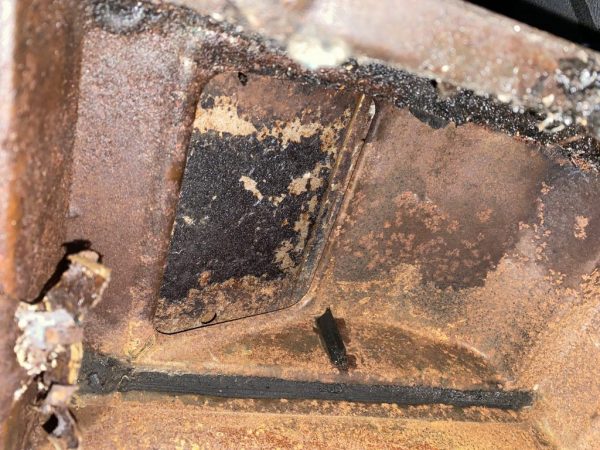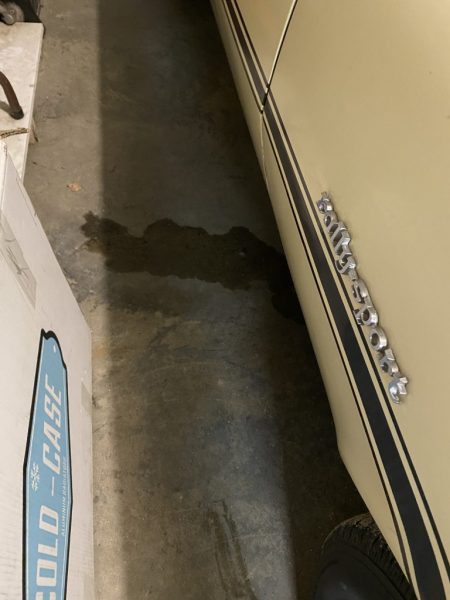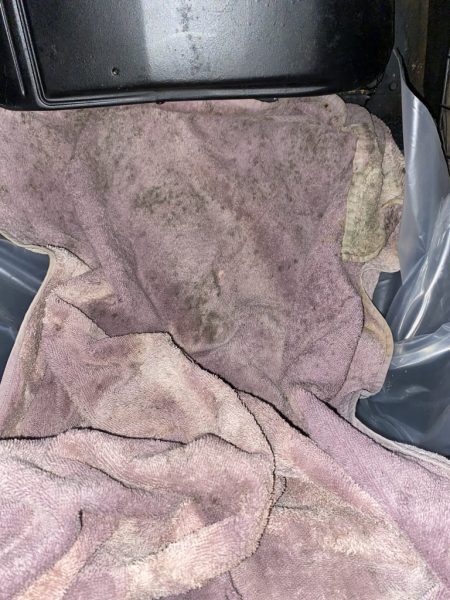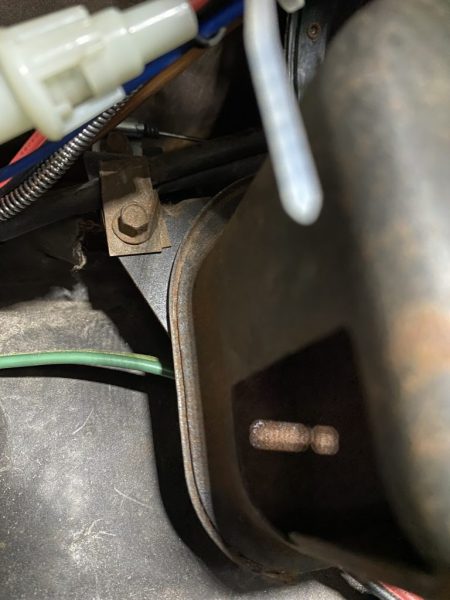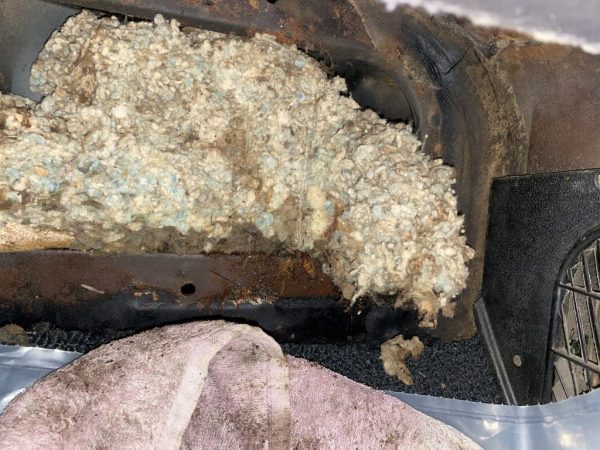A quick shot of black paint to seal up the rest if the ugly
Category: Heating and Cooling
Heater case clean out
Heater core rebuilt
Heater Core Repair
The weather here is getting cold, and although the heater is hooked up, the car wasn’t putting out any significant heat to the defroster or cabin. I took it for a drive a few days ago, and noticed this on the garage floor:
Maybe it’s a loose hose connection inside the engine compartment?
looks damp, but…looking inside the car…
The core is leaking…no question about it.
I really hate plumbing and liquids in cars. I always seem to make a mess no matter how careful I am. I was determined to NOT make a mess this time, so I took some precautions. It ended up working out really well!
First step: drain the radiator. I threaded a piece of vinyl hose down to the bottom of the radiator, and used my mityvac to start a siphon into a trash can.
When I replaced the heater hoses this summer, it made a mess even though I was sure I had drained all the coolant out. I decide to see if I could get more coolant out of the heater core before disconnected the hoses there.
Once it had drained below the level of the water pump, I disconnected the heater hose there.
…and clipped the corner off of a plastic bag so I could blow through it without getting dirt in my mouth.
That forced most of the liquid out of the heater core and into the lower hose…which drained back into the engine block, and was siphoned out with the rest of the coolant in the radiator. After the coolant was finished draining, I removed the heater hoses from the heater core pipes, and…no mess. Nothing came out when I disconnected the hoses.
To be extra sure, I put the vinyl hose into the lower pipe, and used the mityvac to suction out any coolant I could get. I didn’t end up getting anything out, which means forcing the coolant out worked great!
I knew the next step would involve tipping the heater core out to get the pipes out from the firewall holes, and I didn’t want to spill anything, so I rolled up some paper towels and threaded them into the heater core pipes to at least slow down anything that was going to come out.
The next step is taking off the 5 speed nuts holding the heater box onto the firewall. Good news/bad news, there were only two nuts installed on the car, so that went a lot easier than it should have.
Moving to the interior, I put down a big sheet of plastic over the carpet, and put an old towel on top of that to soak up any spills.
Getting the housing out was not simple. I did not take out the glovebox, I did not take out the console, I did not disassemble the center dash section. All three of these would have made the job easier, but so far it isn’t 100% necessary. I may need to do some or all of those things for reassembly, but I don’t know yet.
Things that can and should be disconnected:
– The fan wiring plug on top of the housing should be unplugged
– The plastic diverter piece that sits in the center of the transmission tunnel
– The climate control cables that are attached to the housing.
A tiny 5/16″ ratchet box wrench was the only way to get the mounting screws out of the plastic diverter housing. It was difficult even with that tool. There are several screws that need to be removed.
I didn’t disconnect the cables entirely, mostly because I couldn’t get the circular cable end off of the pegs they were on. I decided I’d be able to get to them easier after it was out from under the dashboard. I did disconnect the mounting brackets that I could get to.
Once those cables were loosened, I was able to pull the housing out to the passenger side. This left the core still in the firewall half of the housing, which means it unsnapped itself from the brackets that hold it into the passenger half of the housing. I’ll worry about that later. I was not able to get the housing completely off because it is still attached to the cables…but I have a better shot at removing them now.
I was able to get the heater core out after the housing was out of the way. Amazingly, I did not spill any coolant getting it out. That’s a huge win in my book as I didn’t want to make a mess of the carpet or the garage floor.
It does not say “Harrison” on it, so I do not think it is original. Because it’s a replacement, I’m not sure it’s worth having it re-cored. Not so much for originality, but just design. An original recore should work and fit better than a cheap modern reproduction.
Not surprisingly, there was a huge mouse nest in the housing, which explains why there wasn’t any significant heat coming out. No airflow!
I’ll clean this out and paint it to prevent further damage before I put it all back together.
Stay tuned…
Winter Project 1: Fix Coolant Leak
I had put a new water pump on just before the July show, but I rushed the job, and there was a leak between the water pump and the block on the LH side. The leak meant that the coolant level was dropping, and the system would not hold pressure, so the temps climbed. The fix was to pull the water pump back off again, clean everything up, and reinstall it with new gaskets. While the system was drained, I decided to replace the old heater core hoses also.
I’ve switched the front accessory mounting brackets over to 1969+ style, which isn’t original, but is a much better arrangement than the 67-68 setup. The earlier setup has the alternator on the LH side supported by a long thin flat bracket. I always thought it looked awkward and not particularly secure. For the 1969 setup, the alternator has a much beefier bracket that attaches on the RH side. The water pump and power steering brackets are different also for the newer setup.
The heater hoses are attached to a bracket on the alternator bracket, then they go through another bracket on the inner fender, and then over to the heater core. I wasn’t really concerned with originality, but as it turned out, the restoration-correct hoses were actually cheaper than the generic ones, so I went with those.
I really hate working with plumbing on cars. No matter what I do, I always seem to end up with a big puddle of something on the garage floor. I put a tube into the radiator and siphoned out all of the coolant into a bucket. Then I started unbolting things, and when I got to the water pump…a bunch of coolant drained out onto the floor. I put the hose into the block and siphoned out even more coolant. That seemed to do the trick, until I disconnected the heater hoses from the heater core, and…more coolant drained out. <sigh>
Once I got everything disassembled, I cleaned up all the surfaces, put new gaskets and RTV on, and bolted the water pump back on. This time I let it sit for about a week before continuing. Partly because I wanted to make sure the RTV was absolutely completely set, and partly because I was busy with other things.
The last part of the refit was installing the new hoses and the hose brackets. The alternator bracket is the 1969+ design, but it is a chrome aftermarket one, so I had to drill a hole in it to attach the hose bracket there. The other hose bracket is on the inner fender. I bought these hose brackets new from a restoration vendor. The fender bracket didn’t want to stay in the square hole in the inner fender. I did some digging and found that the trick is to open the bracket, and put the clip in the hole with the bracket flush against the fender. Then take a pair of pliers and squeeze the clip from the inside of the bracket with some pliers. That pinches the inside together, and forces the outside of the clip to spread out and attach firmly to the fender.
After everything was reassembled, a short test drive showed no leaks, and the temperature stayed right at 180*. A successful fix.
Keeping it Cool
I decided to get a new radiator and avoid the drama. After some research, I settled on a Cold Case radiator. It’s a stock fit bolt- in replacement with a lot more capacity.

It’s a two row core, but the tubes are very wide, so it has a lot of surface area.

Out with the old one core:


…and in with the new. Fit is good, it bolted up to the stock mount points on the radiator support.



My only slight criticism is that the brackets were about 3/8” deeper than they needed to be, so the radiator body was a bit closer to the firewall than I’d expected. This caused a misalignment at the shroud mount bracket. Not a big deal since drilling a second mount hole isn’t too difficult, but it may matter to other people.

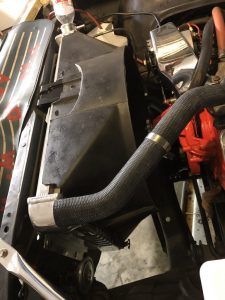
I also got the CORRECT temp sender to work with the idiot light.
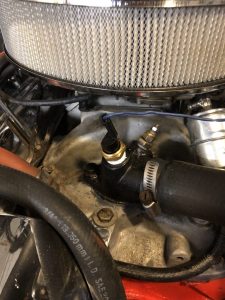
I am waiting on the new power steering pump before I do the final assembly.





